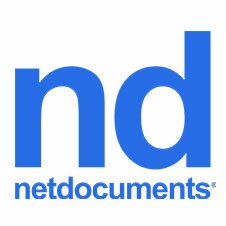NetDocuments: How to develop a legal document management system
Modern law firms and corporate legal teams deal with an enormous volume of documents. And how those documents are managed can increase or impede your productivity.
So how do you make sure you’re not losing money while managing your files?
In this article, we’ll share what a legal document management system (DMS) is and why it’s important, three crucial guidelines for a strong doc management strategy, and how to identify the right DMS solution to support your law firm or legal team.
What is a legal document management system?
A legal document management system refers to the tools and workflows your law firm or legal team uses to create, edit, store, locate, and share documents every day — plus your overarching strategy and guidelines for handling files.
It also refers to a specific type of legal software that supports, enhances, and streamlines your organisation’s document management strategy.
Why is document management important?
Whether you use a DMS or not, it’s important to have a consistent approach for how your team should manage important files. By establishing clear document management guidelines, you can help your teamwork more efficiently and effectively by enabling them to:
- Find documents quickly and easily
- Keep track of version history
- Securely share and collaborate on documents
- Protect confidential files from unauthorised eyes
- Maintain compliance and governance
- …and much more.
So, what sorts of guidelines are vital to a strong document management system and strategy? We’ll dive into three key areas: rules for creating documents, how and where documents are stored, and establishing procedures and workflows.
1. Define rules for document creation.
When you decide to improve your organisation’s document management system, the first thing to do is create rules for creating new documents. For example:
- Document Templates: Are there established templates for frequently used document types, such as NDAs, sales agreements, employment contracts, letters of intent (LOI), etc.?
- File Names: What file naming conventions will you follow? What abbreviations will you use for common descriptions? Will you include the document author’s name or initials? Will you use status indicators (ex. filed, issued, or received)?
- Dates: How will you format dates in filenames. For example, will you use MMDDYY or YYYYMMDD?
- Version Control: If you must handle it manually, how will you keep track of the latest version of a document? Will you use a date/timestamp or the editor’s initials?
- Metadata: Do you need custom metadata fields for digital files? Would any components of your file naming conventions be better as metadata tags?
To create an effective and efficient document management system, consistency is vital. But it’s also important to keep things as simple as you reasonably can. When introducing new document protocols, people are more likely to adopt the new process if it’s easy for them to remember and do.
With these rules in place, you can more effectively prevent unorganised content in your DMS (or worse, misplaced or lost data). Eventually, you can apply your new standards to your backlog of existing files, but first you should make sure that all new documents coming into the system meet your selected requirements.
2. Decide how and where documents will be stored.
Once you’ve standardized your process for creating documents, the next step is to decide how and where to store them — in other words, organize them!
Just as it helps to follow consistent rules for creating and naming documents, it also helps to be consistent about folder naming and file structures, whether you choose to store documents physically, digitally, or a bit of both.
Consistent folder structures make it easy for team members to quickly locate files they need. This is especially crucial when you have a large number of documents, and when you have numerous similar documents (e.g. agreements for multiple clients or vendors).
One great way to ensure your digital folders are consistent is to create a template. It’s likely that your law firm or legal team frequently deals with similar client matters or business projects, so you can use the same folder structure each time.
For example, here’s a basic folder structure or file tree for a litigated matter:

With a template like this in place, you can easily duplicate the folder structure for new clients, or duplicate subfolders for new matters with existing clients.
Of course, every matter or project is different, so it may not be necessary to keep all the subfolders for each one. In that case, it’s easy to delete the subfolders you don’t need, or add unique ones. But you can save a lot of time (and effort) by being consistent.
Document Security Measures
Keeping documents secure is a vital part of your document management system. In addition to overall platform security, you want to ensure that confidential and other important information is protected from unauthorised users — including internal and external threats.
While you can certainly control user access at the document level, it’s typically easier to define those controls at the folder level. Generally speaking, if an individual is not authorised to view one document in a folder, they aren’t permitted to view others.
3. Establish document procedures and workflows.
As wonderful as it would be to create the perfect document the first time, every time, it’s not realistic. Between internal and external reviews, negotiations, and other adjustments, legal documents go through many changes throughout their lifecycle.
That’s why it’s important to ensure that you have clear procedures for creating, organising, reviewing, and approving various types of documents. For example, you may want to create document workflows for:
- New client or project intake
- Integrating externally created documents into your system
- Internal and external document review processes
- Maintaining compliance, including archiving and document disposal
Converting to Digital Document Management
We get it: attorneys love paper. So it’s no surprise that some organisations have a hard time letting go of physical documents (and endless hanging folders and filing cabinets to hold them).
But just because you can create a paper-based document management system doesn’t mean you should.
In fact, doing so would rob you of many powerful benefits that come from a strong document management system and strategy.
On the other hand, using a legal-specific DMS platform can take your team to new heights of productivity and empower them to deliver superior legal services.
How to Choose the Best Legal Document Management System
There are various commercial file storage solutions available on the market today such as Google Docs, Box, and Dropbox. But these tools are not suited to the unique needs of legal professionals, which can cause significant productivity losses — not to mention exposing your organisation to risk.
For a profession that relies so heavily on documents and digital collaboration, a generic solution won’t do (especially when it comes to securing confidential information.) But what should you be looking for in legal-specific document management software?
Key Features of a Legal DMS
As you explore various document management solutions for your organisation, it’s important to know what will truly make a difference for your team. Keep a lookout for some of these powerful DMS features that can give your team of legal professionals a serious productivity boost:
- Anywhere access
- Matter- or project-centric folder organisation
- Document and workspace templates
- Secure document sharing and external collaboration
- Automated version control
- Simultaneous collaboration and discussion
- Advanced user access controls
- Custom metadata fields
- Robust search capabilities
- Email integration
- Workflow and task management tools
- True cloud storage
Using these features, your team can maximise their productivity, stay secure and compliant, collaborate seamlessly, and streamline their workflows so they may work inspired.



